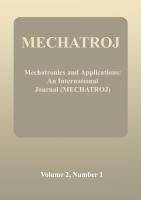Article,
MECHATRONIC MODEL-BASED DESIGN APPLIED TO AN H-BOT ROBOT
Mechatronics and Applications: An International Journal (MECHATROJ), 2 (1): 61-78 (October 2021)
Abstract
Mechatronic system design is multidisciplinary and integration among the mechanical, sensor, actuator, electronic, computer, and control elements is essential. The integration is done simultaneously from the start of the design process and the design is model-based. Modeling, physical and mathematical, is the key in modern engineering practice. Accurate motion control and energy efficiency in industrial machines heavily depend on trajectory planning and the appropriate selection of the motors controlling the axes of the machine. A model-based design approach is proposed for (1) trajectory planning that leads to accurate positioning and energy efficiency and (2) optimized selection of motors prior to building a prototype. As planar positioning is an important task in industrial applications, a two-axis, single-beltdriven, H-frame planar positioning robot called an H-Bot was built. The proposed approach is demonstrated via modeling, analysis, control-design simulation using MatLab / Simulink, and hardware implementation using the Arduino and LabVIEW MyRIO.
Tags
- design
- h-bot
- in
- industrial
- machines
- mechatronic
- motor
- planning
- positioning
- process
- robot
- selection
- system
- trajectory
- xy
